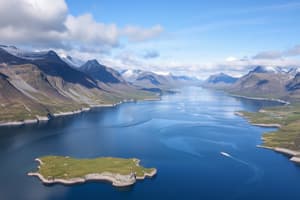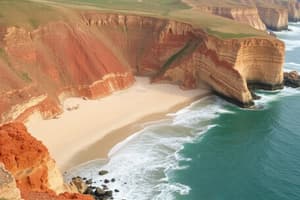Podcast
Questions and Answers
A coastline is the meeting point of land and the seas or ______.
A coastline is the meeting point of land and the seas or ______.
oceans
An elongated ridge of sand or pebbles extending into the water is called a ______.
An elongated ridge of sand or pebbles extending into the water is called a ______.
spit
The boundary of a coast, where land meets water, is called the ______.
The boundary of a coast, where land meets water, is called the ______.
coastline
A needle-shaped column resulting from the collapse of an arch is called a ______.
A needle-shaped column resulting from the collapse of an arch is called a ______.
[Blank], the rise and fall of the ocean, affect where sediment and other objects are deposited on the coast.
[Blank], the rise and fall of the ocean, affect where sediment and other objects are deposited on the coast.
Flashcards
What is a coastline?
What is a coastline?
The meeting point of land and the seas or oceans, including beaches, cliffs, capes, caves, bays, and estuaries.
Stack
Stack
A needle-shaped column resulting from the collapse of an arch.
Spit
Spit
Elongated ridge of sand or pebbles extending into the water.
Tombolo
Tombolo
Signup and view all the flashcards
Coastline
Coastline
Signup and view all the flashcards
Study Notes
- A coastline marks the meeting point of land and sea.
- Coastlines feature beaches, cliffs, capes, caves, bays, and estuaries.
- Smaller landforms line up along a coast.
Coastal Features
- Natural arches are arches hollowed out of a headland by the sea.
- Rocky islets are small islands made of rock.
- A skerry is a rock tip that is just above the water's surface.
- Spits are elongated ridges of sand or pebbles that extend into the water.
- Cliffs are steep rock faces shaped by the sea.
- Sand islands are summits of sand deposits that are exposed near or far from a shoreline.
- Tombolos are ridges of sand that join an island to the shoreline.
- Beaches are accumulations of sand or pebbles along a coast.
- Dunes are accumulations of sand shaped by the wind.
- River estuaries are mouths of rivers influenced by tides and form indentations in the coastline.
- Caves are natural underground cavities that result from the slow dissolution and erosion of rock by water.
- Lagoons are shallow expanses of seawater that are separated from the sea by a ridge of sand or barrier island.
- Stacks are needle-shaped columns resulting from the collapse of an arch.
- Headlands are tapering strips of land that jut into the sea.
Weathering and Cliffs
- Freeze-thaw weathering can cause cliffs to break down.
- Solution (chemical weathering) breaks down calcium carbonate (limestone) cliffs.
- Plants can cause cliffs to break down.
Changing Coastlines
- The coast is the land along a sea, and the coastline is the boundary where land meets water.
- Waves, tides, and currents play a role in shaping coastlines.
- Waves erode the land and leave behind sediment.
- Coastal changes can take hundreds of years.
- The way coasts are formed depends on the material in the land and water.
- Harder material in the land is more resistant to erosion.
- Coastlines of granite are stable for centuries.
- Tides affect where sediment is deposited on the coast.
- Tidal range impacts the distance material is deposited inland.
- Larger waves carry more energy and can move more sediment.
- Coastlines with big beaches have more room for waves to spread their energy and deposits.
- Small, narrow beaches focus wave energy, giving them a tattered look.
- Sandy beaches are washed away, and rocky coastlines get cracked by strong waves.
- Coasts reveal information about weather and changing sea levels.
- Coasts are the first places to be flooded during storms.
- Coastal plains are flat, low-lying land that can become visible when sea levels decrease.
- Coasts are affected by pollution, oil spills, and garbage, damaging marine life.
Studying That Suits You
Use AI to generate personalized quizzes and flashcards to suit your learning preferences.




